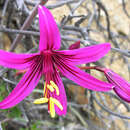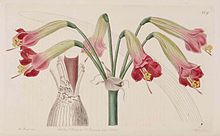en
names in breadcrumbs


Phycella is a genus of herbaceous, perennial bulbous flowering plants belonging to the family Amaryllidaceae, subfamily Amaryllidoideae. The genus consists of five species distributed from central Chile to northwestern Argentina.[7]
The genus was described by John Lindley in 1825.[8][1] After further examining specimens of Amaryllis ignea (see illustration) that he had described the previous year as Amaryllis, with some reservation,[6] Lindley concluded they were a separate genus, naming two species, P. ignea, and P. cyrtanthoides (previously A. cyrtanthoides). Subsequently, it was considered these were the same plant, and P. ignea was reassigned to a synonym for P. cyrtanthoides.[9]
Phycella is located in the American (Hippeastroid) clade of the Amaryllidoideaetribe, where it is placed in tribe Hippeastreae, subtribe Traubiinae. In molecular phylogenetic analysis, Phycella forms a sister group to the remainder of the Hippeastreae.[10] In 1996 the Müller-Doblies' had situated it in subtribe Hippeastrinae based on morphological criteria, by submerging it in Hippeastrum.[11] A detailed study of in-depth relations within Hippeastreae revealed a more complicated situation wit regard to the Chilean-Argentinian taxa which had not been well represented in earlier studies. There was strong support for two major clades, representing two subtribes, with Phycella and three other genera (but not Hippeastrum) forming the Traubiinae. This study also showed that one species of Famatina (F. maulensis) segregated with Phycella, and was therefore submerged in it as Phycella herbertiana.[12] By contrast the remaining three Famatina species segregated with Rhodophiala and were therefore grouped in Hippeastrinae together with Hippeastrum. Consequently, Famatina has been extinguished as separate genus.[13] The genus Placea was also submerged in Phycella, resulting in about 13 species in total.[3]
13–14 species are described:[14][3]
 Phycella cyrtanthoides, original specimen, described as Amaryllis ignea, 1824
Phycella cyrtanthoides, original specimen, described as Amaryllis ignea, 1824 Phycella is a genus of herbaceous, perennial bulbous flowering plants belonging to the family Amaryllidaceae, subfamily Amaryllidoideae. The genus consists of five species distributed from central Chile to northwestern Argentina.